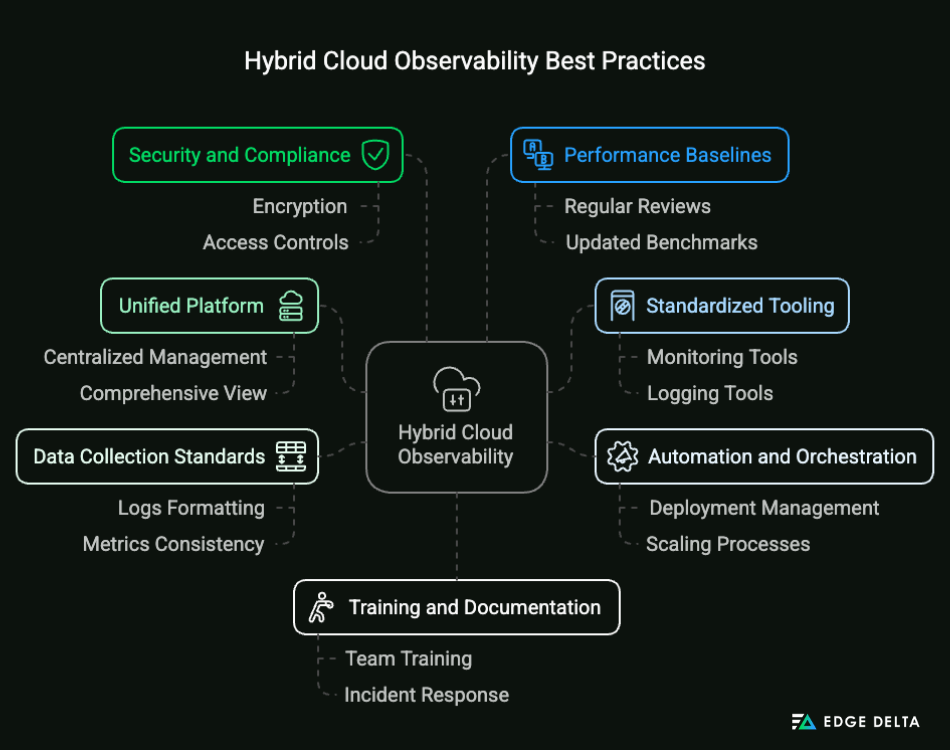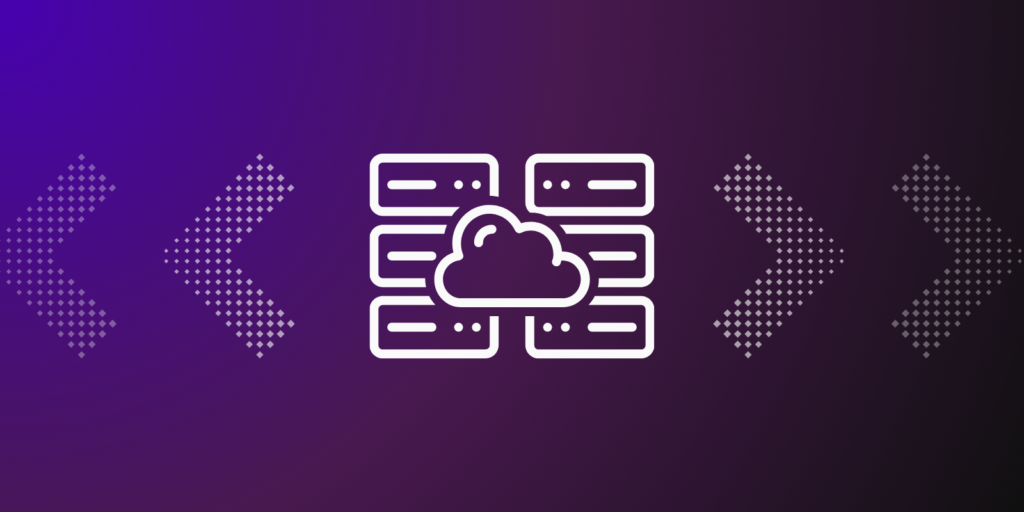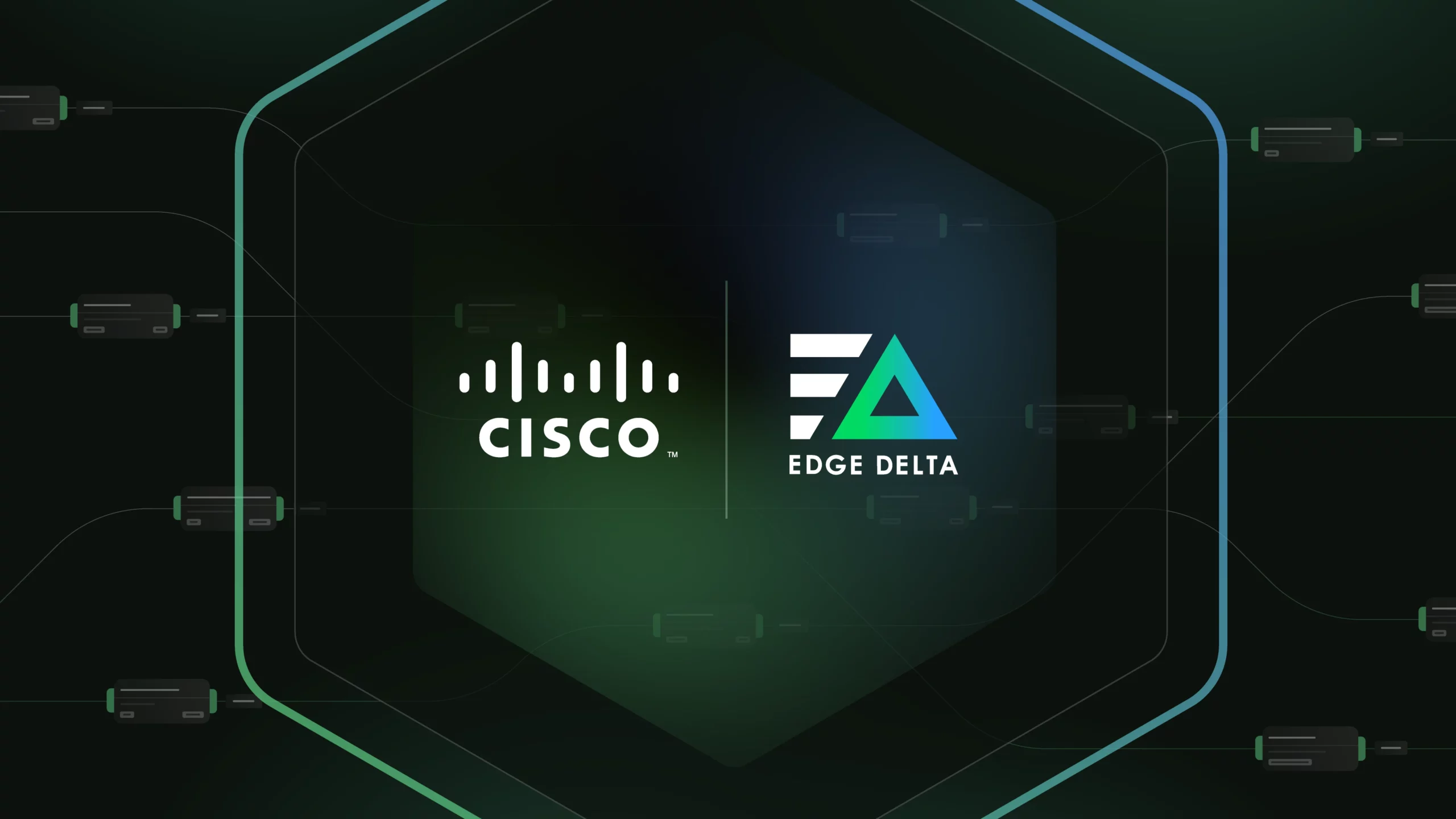Hybrid cloud observability is the comprehensive monitoring, management, and analysis of applications, services, and infrastructure in both on-premises and cloud environments. It collects and analyzes data from events, metrics, logs, and traces to give a complete view of system health.
This approach integrates data from various sources to ensure reliable and secure hybrid cloud deployments. Unlike traditional observability, which focuses on a single environment, hybrid cloud observability tackles performance, security, and resource allocation across multiple platforms.
Effective observability solutions improve hybrid cloud operations by optimizing performance, security, and cost management. However, hybrid cloud environments have unique challenges that can impact performance and security. Understanding and addressing challenges is essential for maximizing the benefits of hybrid cloud strategies.
Keep on reading to discover hybrid cloud observability challenges and solutions.
| Key Takeaways • In hybrid cloud environments, data silos prevent unified views and root cause analysis. • Tool sprawl complicates observability by creating redundant processes, increasing complexity, and reducing visibility and performance. • Integrated performance monitoring improves issue resolution and provides consistent views despite different tools. • Using unified security tools and policies helps maintain compliance and security through complex protocols. • AI and machine learning can detect anomalies, reducing downtime and enabling proactive resource management. • Automated orchestration improves data flow and problem-solving by reducing manual monitoring and increasing efficiency. |
What are Common Hybrid Cloud Challenges?
A hybrid cloud integrates on-premises infrastructure, private cloud services, and public cloud services into a flexible IT architecture. This integration lets data and applications move freely between environments, helping organizations optimize resources, efficiency, and scalability.
A typical hybrid cloud can simultaneously involve the following common components:
- Public cloud: Provided by third-party cloud providers and is accessible over the internet. They offer scalable computing resources, such as virtual machines, storage, and networking, on a pay-as-you-go basis.
- Private cloud: Dedicated solely to one organization and can be located on-premises or hosted by a third-party provider. It offers similar benefits to the public cloud, such as scalability and self-service provisioning, but with added control, customization, and security. Organizations with strict compliance requirements or sensitive data that cannot be stored in a public cloud use private clouds.
- On-premises infrastructure: Refers to computing resources that are owned, operated, and maintained by an organization within its own data centers or facilities. This includes servers, storage devices, networking equipment, and other hardware and software resources. On-premises infrastructure provides full control and customization but may lack the scalability and flexibility of cloud environments.
The integration of these components in a hybrid cloud environment provides several key benefits:
- Flexibility: Hybrid clouds provide the flexibility to choose where data and applications are hosted, ensuring compliance with data regulations and addressing security concerns.
- Scalability: Combining the public and private clouds allows businesses to easily scale their infrastructure up or down based on their needs, ensuring optimal performance at all times.
- Cost-efficiency: By utilizing public clouds for non-sensitive workloads, organizations can reduce infrastructure costs while maintaining heightened security and control over sensitive data.
- Improved Disaster Recovery: Hybrid cloud solutions offer robust disaster recovery capabilities. Organizations can keep critical data and applications on the private cloud while using the public cloud for backup and redundancy purposes.
However, managing and integrating multiple cloud and on-premise systems involves some complexities. Read on to learn about the top observability challenges in hybrid environments.
Observability Challenges in Hybrid Cloud Environments
Hybrid cloud environments offer compelling benefits but have some notable challenges. Many organizations struggle to monitor performance, security, and operational management across their on-premises and cloud environments.
Below are four top observability challenges in hybrid cloud environments that can significantly impact the management and optimization of IT resources.
Data Silos
Data silos happen when only specific departments can access data. It prevents the integration and correlation of disparate data sources, limiting the effectiveness of observability tools. Without a unified data view, identifying root causes and discerning trends can be challenging. As a result, departments can’t access or share important information, leading to operational inefficiencies and redundant processes.
For example:
In healthcare, data silos can critically impact patient care and operational efficiency. Hospitals often use separate systems for electronic health records (EHR), billing, and scheduling. For example, clinicians might access an EHR system for patient medical histories, while the billing department uses a different insurance and payment details system.
Impact:
This separation can make clinicians unaware of insurance coverage, potentially affecting treatment options. Billing departments may not receive timely updates on patient treatments, causing billing errors and delays. The disconnection hinders holistic care coordination, procedure scheduling, and insurance policy compliance, ultimately affecting healthcare delivery and administrative operations.
By addressing these data silos, organizations can significantly enhance their capacity to monitor, analyze, and act upon data-driven insights, ultimately leading to improved operational performance and decision-making.
| Side Note: Detecting data silos is the first step toward resolving them. However, this can be challenging as teams within a company often operate independently. Key indicators include: – Complaints about data shortages for business initiatives.Lack of data showing a holistic business view. – Inconsistent data reports and persistent errors across departments. – Uncertainty about metrics used by teams. – Slow data access. |
Tool Sprawl
Tool sprawl is the accumulation of multiple IT management and monitoring tools for the same or similar purposes. As numerous tools are used for the same purpose, sprawl can lead to redundant processes. It can also be costly, as tools are purchased and then abandoned due to their excessive nature.
The proliferation of monitoring tools can complicate observability. Organizations may use various observability tools, such as monitoring and logging, that must be integrated to provide a unified view of system performance. Multiple tools may use different data formats and protocols, making this difficult.
Tool sprawl can cause myriad problems for organizations, including the following:
- Reduced Visibility: Many tools make observability difficult for IT teams. They often struggle to discover how tools are used, who uses them, and their impact on operations. Installing tools without IT approval can create a shadow IT environment with hundreds of applications that teams can not see.
- Increased Complexity: Tool sprawl also introduces unnecessary complexity. If multiple tools are allowed to monitor the same application, each tool may create its own data silo, leading to a fragmented IT environment.
- Diminished Performance: From an employee perspective, tool sprawl creates standardization and communication problems. Verifying data and making decisions takes longer when teams and departments use different tools. From a network performance standpoint, using more tools means using more power, computing, and storage resources. Therefore, as tool sprawl increases, performance decreases.
For example:
A company with on-premises servers and cloud services from different providers may use separate tools to monitor their infrastructure. This setup requires switching between interfaces, correlating data manually, and managing separate alerting systems. This system can lead to delays in issue resolution and difficulties in maintaining a comprehensive view of the system.
Impact:
This system can lead to delays in issue resolution and difficulties in maintaining a comprehensive view of it. Organizations can consider adopting a unified observability platform that integrates data from all environments to address this challenge and provide a centralized view of their infrastructure and applications.
Performance Monitoring
The diversity of hybrid cloud systems, which combine on-premises infrastructures with private and public clouds, makes performance monitoring difficult. Each segment requires different monitoring tools and strategies, complicating consistent performance tracking.
One major obstacle to effective hybrid cloud monitoring is the different monitoring approaches and tooling required for on-premises and cloud environments. Legacy network security tools and appliances, which are often used for on-premises monitoring, may not be fully compatible with cloud environments. This lack of compatibility can make it challenging to track performance metrics across hybrid environments effectively.
Other factors that make hybrid cloud monitoring challenging include:
- Difficulties in discovering, developing, and maintaining an up-to-date topology.
- The vast scale of metrics generated across a complex environment.
- Siloed cloud provider tools can’t offer a complete picture.
- Challenges with implementing agent-based legacy monitoring in dynamic cloud environments.
- The complexity of instrumenting modern apps and services for logging and monitoring.
- There is a shortage of IT personnel skilled in managing hybrid cloud environments.
Example:
An on-premises server and public cloud service company monitors each segment with different tools and strategies. This setup complicates performance tracking due to the incompatibility of legacy on-premises monitoring tools with cloud environments.
Impact:
The IT team struggles to maintain an up-to-date topology and manage the vast number of metrics generated across the hybrid environment. Siloed cloud provider tools lead to an incomplete performance picture, making issue resolution difficult. To address these challenges, the company could adopt a unified monitoring solution that offers a comprehensive view of both on-premises and cloud environments.
Security Compliance
Security compliance in hybrid cloud environments entails navigating a complex landscape due to the integration of private clouds, public clouds, and on-premises resources. Each component has security protocols and compliance standards, making platform-wide observability and compliance difficult for IT and security teams.
Maintaining security and compliance in hybrid cloud environments presents the following challenges:
- Fragmented control planes: Multiple control planes in hybrid environments lead to fragmented security policies and procedures. Each cloud provider and on-premises infrastructure may have its own security tools and data formats, complicating achieving a unified security management view.
- Inconsistent security configurations: Security configurations may vary across environments, creating exploitable gaps. Discrepancies between the security measures in different cloud settings and on-premises servers add complexity to compliance efforts.
- Complexity of compliance across jurisdictions: Hybrid clouds frequently span several different geographical locations, each subject to various regulatory and compliance requirements. Ensuring adherence to all local and international regulations, which may change frequently, adds to the complexity.
- Lack of visibility and control: It is challenging to gain comprehensive visibility into every component of a hybrid cloud. Security teams must monitor various elements, such as virtual machines, containers, and services, across multiple clouds and on-premises environments to ensure full compliance and detect security breaches.
- Data governance and sovereignty issues: Managing data stored and processed in multiple locations involves navigating data sovereignty and governance challenges. Organizations must follow each jurisdiction’s data storage and management laws.
- Integration of legacy systems: Integrating legacy systems not initially designed for cloud environments can introduce vulnerabilities. This approach is particularly true if these systems are outdated or lack support for modern security protocols.
Example:
In financial services, maintaining compliance across various regions is critical. For example, a global financial company might use public cloud services for scalability and private clouds for sensitive data. The company must comply with GDPR in Europe and PCI-DSS for payment information. Ensuring consistent security policies and compliance reporting across these different environments is a significant challenge.
Impact:
Visibility gaps from disparate monitoring tools hinder a unified view of security and compliance, leading to unnoticed vulnerabilities and breaches. Inconsistent security policies weaken security and cause non-compliance. Regulatory risks include severe penalties, legal issues, and loss of customer trust, damaging the company’s reputation and financial stability. Robust observability solutions integrated across platforms are essential for comprehensive security and compliance.
Solutions to Hybrid Cloud Observability Challenges
Understanding the intricacies of hybrid cloud environments demands advanced tools and strategies that can seamlessly handle cloud and on-premises resources. Observability platforms have risen to the challenge, offering unified solutions that not only simplify management but also enhance performance and security.
Keep reading to learn some solutions to hybrid cloud observability challenges:
Unified Observability Platforms
Unified platforms consolidate monitoring, logging, and tracing data from various sources into a single, coherent framework. This integration helps IT teams identify and fix issues across environments by providing a holistic view of infrastructure health and performance.
Benefits of utilizing a unified observability platform:
- Comprehensive data integration: By aggregating data from multiple cloud and on-premises sources, unified platforms eliminate silos, allowing for more effective data analysis and management.
- Enhanced problem detection and resolution: With a complete view of the system’s operations, these platforms facilitate faster anomaly identification and troubleshooting, reducing downtime and improving service reliability.
- Streamlined operations: Unified observability tools automate many routine monitoring tasks, freeing up IT staff to focus on more strategic initiatives.
- Scalability and flexibility: As business needs change, these platforms can scale and adapt, providing consistent observability across new and existing environments.
- Security improvements: Integrated observability aids in detecting security threats across all parts of the hybrid cloud, improving overall protection.
AI and Machine Learning
Artificial Intelligence (AI) and Machine Learning (ML) are revolutionizing how organizations handle data across various platforms, particularly in hybrid cloud ecosystems. AI and ML can improve the accuracy of observability tools and provide proactive insights into system performance and behavior.
Furthermore, ML algorithms are adept at recognizing intricate patterns within large datasets, which might be overlooked using traditional analysis techniques. This is particularly crucial in such fragmented environments. Additionally, the scalable nature of AI-driven analytics allows organizations to leverage cloud resources to adapt to fluctuating data demands efficiently.
AI and ML can significantly enhance data analysis, anomaly detection, and predictive insights in hybrid cloud environments through several mechanisms:
- Automating and optimizing tasks: AI facilitates substantial automation within hybrid cloud ecosystems. It streamlines operations by managing tasks such as resource provisioning, application deployment, and security management across multiple clouds. This automation not only cuts down on the time and effort involved in managing these environments but also enhances applications’ overall performance.
- Improving anomaly detection: AI models can detect anomalies in real-time, which is crucial in hybrid environments with continuous and distributed data flows. Moreover, ML models are adaptive; they evolve as data patterns change, thus enhancing anomaly detection accuracy over time.
- Enhancing security and providing predictive insights: Security enhancement is another critical area where AI can make a substantial impact. By analyzing user and application behaviors, AI can identify potential security risks and mitigate them proactively.
AI’s predictive capabilities are invaluable for operational planning. Techniques like predictive maintenance can foresee potential system failures, reducing downtime and maintenance costs. Similarly, demand forecasting helps predict future resource needs, enabling more effective resource allocation and cost management.
| Did You Know? Did you know that AI and ML can turn traditional observability into a self-healing system? In hybrid cloud environments, AI-driven observability tools can automatically detect issues, diagnose root causes, and even trigger corrective actions. This capacity reduces downtime and allows IT teams to focus on strategic projects, making the system more resilient and efficient. |
Automated Orchestration
Cloud orchestration and automation are pivotal in effectively managing hybrid cloud environments, particularly in enhancing observability. Observability is critical as it allows IT teams to monitor and understand the performance of their infrastructure across various cloud and on-premises environments.
Automation in the context of hybrid cloud observability involves the reduction of manual intervention by automating routine monitoring tasks and responses. This automation is crucial for several reasons:
- Efficiency: Automation speeds up the collection and processing of data from multiple sources, enabling real-time analysis and insights.
- Accuracy:Automated systems reduce human error, providing more accurate data for decision-making.
- Scalability: As infrastructure grows, automation supports scaling observability processes without a proportional increase in effort or resources.
Orchestration works in tandem with automation by coordinating automated tasks across different cloud environments. This is essential for maintaining a holistic view of the IT landscape and ensuring that automated actions are triggered at the right time and in the right context. Orchestration enhances observability by:
- Centralized Management: Orchestrating cloud tasks allows for a centralized management platform, simplifying distributed environment oversight.
- Integrated Workflows: Orchestration connects disparate workflows across multiple clouds and platforms, ensuring that data flows seamlessly for comprehensive monitoring.
- Proactive Problem–solving: With orchestrated systems, IT teams can proactively address issues before they escalate, using interconnected workflows that anticipate and react to changes across the environment.
In a hybrid cloud setup, automation serves to streamline observability by:
- Automating Data Collection: Gathering metrics, logs, and traces from various sources automatically ensures that data is consistently available for analysis.
- Event-driven Responses: Automation can trigger responses based on specific events detected through monitoring tools, reducing the need for constant human oversight.
- Continuous Integration/Continuous Deployment (CI/CD) Pipelines: Automating CI/CD processes ensures that updates and deployments do not disrupt observability and that monitoring tools are integrated into new services from the outset.
Orchestration reduces manual intervention by:
- Coordinating automated tasks: Ensuring that automation scripts and tools work in concert across the cloud environment reduces the need for manual coordination.
- Workflow optimization—Orchestration optimizes workflows, minimizing manual checks and adjustments, making operations more efficient and less prone to error.
- Policy enforcement: Orchestration can enforce policies across environments automatically, ensuring compliance and governance without manual monitoring.
Automation and orchestration in hybrid cloud observability, including Google Cloud observability, simplifies multi-cloud environments and improves IT teams’ ability to adapt quickly. This dynamic duo is indispensable for businesses aiming to leverage the full potential of their IT investments while maintaining control, compliance, and efficiency.
Standardization and Best Practices for Hybrid Cloud Observability
Adopting standardized practices and frameworks is crucial for enhancing system visibility and operational reliability when managing observability in hybrid cloud environments. Here are some key recommendations:

- Unified observability platform
Utilize a single platform that integrates both on-premises and cloud-based systems. This platform should provide a comprehensive view of all infrastructure, services, and applications, enabling centralized management and analysis.
- Standardized Tooling
Standardizing tooling in a hybrid cloud environment improves observability, consistency, and simplicity. Choose compatible, widely supported tools for monitoring, logging, and tracing across various platforms, and leverage automation and integration to streamline workflows. Implement tools with robust data correlation and analytics capabilities, ensuring compliance with security standards and cost management.
- Automation and Orchestration
Implement automation tools for managing deployments, scaling, and recovery processes. Use orchestration platforms like Kubernetes to support hybrid environments and maintain consistency across different infrastructures.
- Data Collection Standards
Define clear standards for data collection, ensuring logs, metrics, and traces are consistently formatted across all systems. This standard simplifies data aggregation and analysis, making diagnosing issues and understanding system behavior easier.
- Security and Compliance
Maintain strict security standards and compliance across all cloud and on-premises systems. This includes consistently applying security policies, regular audits, and the use of encryption and access controls.
- Performance Baselines and Benchmarks
Establish performance baselines and benchmarks to identify deviations that may indicate problems quickly. Regularly review and update these benchmarks to reflect changes in the operational environment.
- Training and Documentation
Ensure teams are well-trained on the tools and practices in place. Maintain comprehensive documentation to help onboard new team members and serve as a reference during incident responses. Lack of documentation is one of the most common mistakes in observability implementation.
By implementing these practices and embracing a unified approach to observability, organizations can better manage the complexities of hybrid cloud environments, leading to improved performance, faster issue resolution, and higher system availability.
Here are some of the best practices for hybrid cloud observability:
- High-quality, Structured Logging
Structured logging standardizes log data for easier analysis, optimizing log querying and issue resolution. High-quality logs focus on relevant and actionable information, improving troubleshooting processes and decision-making.
- Distributed Tracing
In microservice architectures, distributed tracing tracks requests through services and identifies latency and bottlenecks. This approach enhances visibility into complex system behaviors, optimizing performance and reliability.
- Leveraging AI and Machine Learning
AI and machine learning can automatically analyze large amounts of data to find patterns, anomalies, and trends that humans may miss. These tools detect and fix issues early and optimize performance by predicting resource demand and updating configurations.
- Open Standards Adoption
Embrace open-source observability like OpenTelemetry to ensure interoperability and consistency across different tools and environments.
- Governance Framework Development
Establish a governance framework to define roles, responsibilities, and processes for observability, including guidelines for data collection, retention, and analysis.
- Consistent Metrics Collection
Define and standardize the metrics collected across all environments to maintain uniformity and simplify the analysis process.
- Comprehensive Tracing
Adopt distributed tracing tools to gain end-to-end visibility into requests as they traverse different services in hybrid cloud setups.
- Automated Alerting and Incident Response
Establish automated alerting mechanisms to promptly identify and respond to issues, integrating with incident response platforms.
- Infrastructure as Code (IaC)
IaC tools manage and provision cloud resources, ensuring consistent and repeatable configurations across environments.
Conclusion
Managing hybrid clouds necessitates balancing the strengths of on-premises systems and cloud service providers against challenges. Key challenges include managing data silos, dealing with tool sprawl, ensuring effective performance monitoring, and maintaining stringent security compliance.
Despite these obstacles, the strategic advantages—such as enhanced flexibility and optimized cost management—often justify the investment in advanced observability solutions. By addressing these challenges head-on, organizations can harness the full potential of hybrid cloud environments, ensuring robust, scalable, and secure operations.
FAQs Hybrid Cloud Observability Challenges and Solutions
What are the major challenges of adopting a hybrid cloud approach?
There are apparent challenges when using a hybrid cloud, making it difficult to adopt a cloud strategy. These challenges include security, management, complex migration processes, partitioning, overall trust issues, scheduling, and execution issues, among others.
What are the challenges of observability?
Observability requires managing dynamic multi-cloud environments and real-time microservice monitoring. Moreover, high volumes of data and rapid data generation complicate error cataloging and alerting. Cross-team collaboration is needed for observability, but data and infrastructure silos can hinder it. In addition, choosing and tracking metrics that support business goals is crucial and difficult.
What is hybrid cloud observability?
Hybrid cloud observability allows you to understand how applications and services in a hybrid cloud environment, which combines public, private, and on-premises infrastructure, perform. It increases visibility, intelligence, and productivity to help organizations ensure availability and reduce remediation time across on-premises and hybrid cloud environments.
What are the operations management challenges in a hybrid cloud environment?
Managing a hybrid cloud environment faces challenges like integrating diverse systems for cohesive function. Another is integrating management tools into cloud and on-premises setups and adhering to data security and regulatory requirements.
List of Sources






